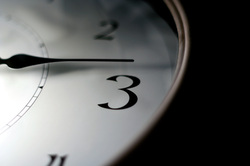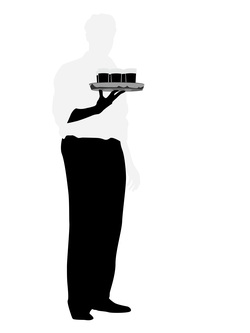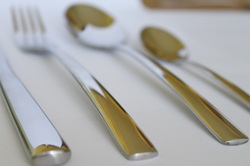Eating My Way Though Europe
Dining Customs
The French don't go to priests, doctors, or psychiatrists to talk over their problems; they sit in a cafe over a cup of coffee or a glass of wine and talk to each other.
-Eric Sevareid
-Eric Sevareid
Time
The French concept of mealtime is different from most Americans. For the French, the meal is a social leisure activity, meant to be savored. Americans are usually more practical and view meals as a solution for hunger. So while some Americans scarf down their entree (and maybe an appetizer), most French meals are drawn out over three to seven courses. The average American meal only takes an hour (or less), but the average French meal is between 2 and 3. When you consider that the French normally begin dinner between 8 and 9, the experience takes up a considerable amount of each evening. The French also like to linger over a long lunch, when the restaurants are busiest between 1 and 3 (Brown & Wang, 2007, 90).
The French concept of mealtime is different from most Americans. For the French, the meal is a social leisure activity, meant to be savored. Americans are usually more practical and view meals as a solution for hunger. So while some Americans scarf down their entree (and maybe an appetizer), most French meals are drawn out over three to seven courses. The average American meal only takes an hour (or less), but the average French meal is between 2 and 3. When you consider that the French normally begin dinner between 8 and 9, the experience takes up a considerable amount of each evening. The French also like to linger over a long lunch, when the restaurants are busiest between 1 and 3 (Brown & Wang, 2007, 90).
Service
Tipping your waiter is not necessary, or even expected, in France. Most waiters would probably be grateful to receive a tip of the change left over from breaking a euro. In contrast to the concept that a waiter depends on their tips for income (like in America), French waiters are paid a full salary. They do not rely on their customers for income, which changes the very dynamic of service. In America, waiters are generally overtly friendly and willing to please. In France, they have a more laid-back attitude towards service, which is also a polite way of saying the service is slow by American standards. As someone used to American service, I also found French waiters to be inattentive and cold in comparison. However, all the waiters I met were polite. One benefit of having servers earn a full salary is that they don't ever try to hurry you out the door so they can turn their table over to more customers. When you reserve a table in France, it is often expected that you have reserved the table for the entire evening. You are free to eat yor meal at whatever pace you like, with minimal interruptions from your waiter.
Tipping your waiter is not necessary, or even expected, in France. Most waiters would probably be grateful to receive a tip of the change left over from breaking a euro. In contrast to the concept that a waiter depends on their tips for income (like in America), French waiters are paid a full salary. They do not rely on their customers for income, which changes the very dynamic of service. In America, waiters are generally overtly friendly and willing to please. In France, they have a more laid-back attitude towards service, which is also a polite way of saying the service is slow by American standards. As someone used to American service, I also found French waiters to be inattentive and cold in comparison. However, all the waiters I met were polite. One benefit of having servers earn a full salary is that they don't ever try to hurry you out the door so they can turn their table over to more customers. When you reserve a table in France, it is often expected that you have reserved the table for the entire evening. You are free to eat yor meal at whatever pace you like, with minimal interruptions from your waiter.
Menu
One thing I love about France is that the law requires eateries to post their menu (la carte) outside. Therefore, you can decide whether a restaurant appeals to your taste and budget before committing to stepping inside. Most French restaurants have a prix fixe menu, which is my favorite way to dine. The prix fixe menu usually consists of two or three courses for a cheaper price than ordering courses separately, or "a la carte." Sometimes the prix fixe menu even includes a glass of wine! This type of menu is often a wonderful bargain compared to ordering straight from the regular menu. The only drawback is that your selection may be limited in a prix fixe menu, but if you're willing to try new dishes, you'll rarely be disappointed. Another element that French menus emphasize is fresh ingredients. There are often chef specials, or "plat du jours" based upon what the chef bought from the market that morning. This option is a great way to sample the skills of different chefs on your path to culinary delight (Gustafson, 2007, p. 21).
One thing I love about France is that the law requires eateries to post their menu (la carte) outside. Therefore, you can decide whether a restaurant appeals to your taste and budget before committing to stepping inside. Most French restaurants have a prix fixe menu, which is my favorite way to dine. The prix fixe menu usually consists of two or three courses for a cheaper price than ordering courses separately, or "a la carte." Sometimes the prix fixe menu even includes a glass of wine! This type of menu is often a wonderful bargain compared to ordering straight from the regular menu. The only drawback is that your selection may be limited in a prix fixe menu, but if you're willing to try new dishes, you'll rarely be disappointed. Another element that French menus emphasize is fresh ingredients. There are often chef specials, or "plat du jours" based upon what the chef bought from the market that morning. This option is a great way to sample the skills of different chefs on your path to culinary delight (Gustafson, 2007, p. 21).
Manners
The following are some tips to keep in mind when dining in France (Gustafson, 2007, p. 35):
* Space is limited in much of Europe, so don't be surprised if you're rubbing elbows with your neighbors.
* There's no concept of a doggie bag - you can't take your leftover meal home with you. Fortunately, portions are generally smaller than in the U.S., so it's not a big issue.
* The French use a knife and fork to eat many dishes Americans would eat with their hands, such as fries, chicken, and fruit. You may stand out if you use your hands to eat.
* There's no formal dress code in many restaurants, but not wearing gym shorts and flip-flops (which would be commonplace in Austin, TX) is appreciated.
* Be polite, of course!
The following are some tips to keep in mind when dining in France (Gustafson, 2007, p. 35):
* Space is limited in much of Europe, so don't be surprised if you're rubbing elbows with your neighbors.
* There's no concept of a doggie bag - you can't take your leftover meal home with you. Fortunately, portions are generally smaller than in the U.S., so it's not a big issue.
* The French use a knife and fork to eat many dishes Americans would eat with their hands, such as fries, chicken, and fruit. You may stand out if you use your hands to eat.
* There's no formal dress code in many restaurants, but not wearing gym shorts and flip-flops (which would be commonplace in Austin, TX) is appreciated.
* Be polite, of course!





